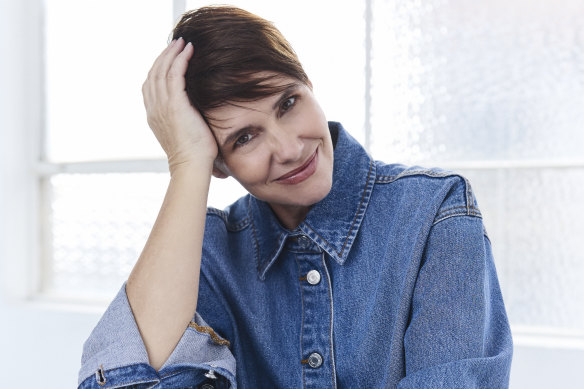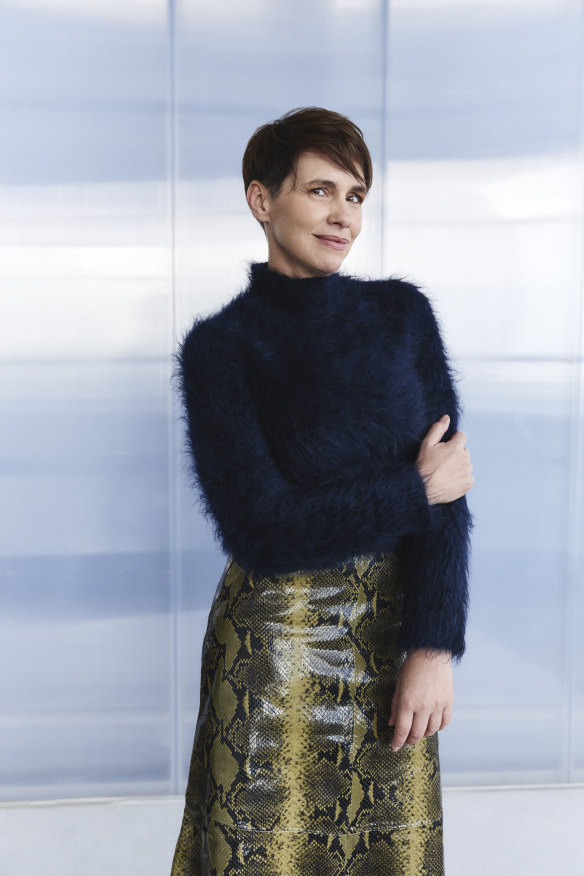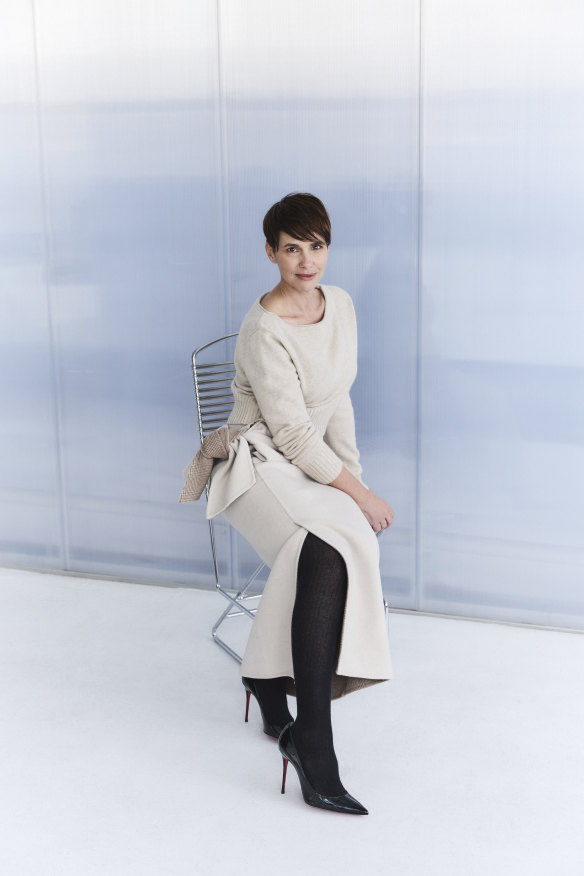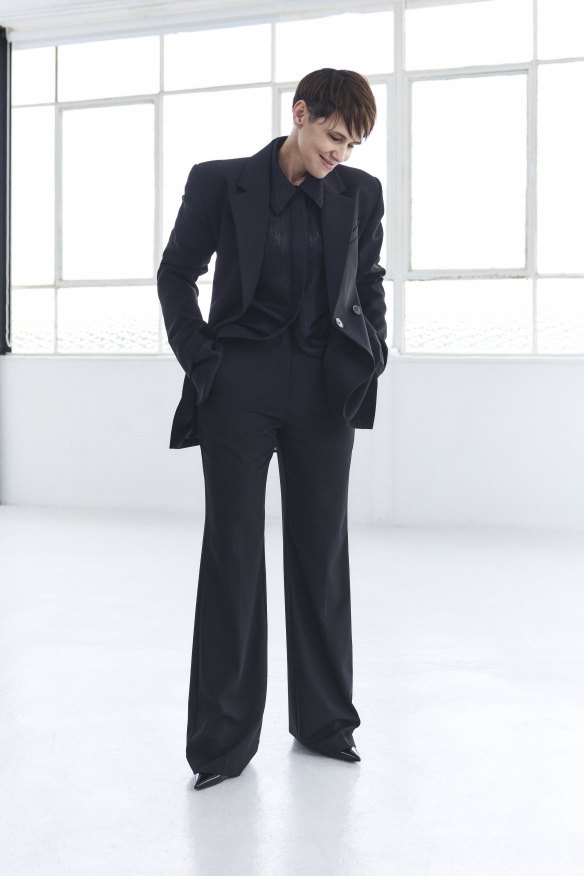‘You hid your identity’: Why Tasma Walton’s Indigenous past was a mystery for years
In her latest role, the 50-year-old star of The Twelve goes on a journey of identity not unlike the one she’s taken in real life.
By Steve Dow

Tasma Walton wears Camilla and Marc shirt and jeans. Credit: JEDD COONEY
ON a beach on Bunurong country in Victoria’s Point Nepean National Park not so long ago, actor Tasma Walton and Indigenous elder Aunty Gail Kunwarra Dawson, lit a cleansing fire. In that moment, Walton, star of Rake and Mystery Road, vividly pictured the day, almost 200 years earlier, when sealers abducted a group of Indigenous girls and young women around that spot.
Walton suddenly felt the intensity of the grief in this “sorry place”, thinking of that day in 1833 when those females were grabbed, bound and forced inside a schooner. Among those on board were girls as young as eight and 10, a couple of 14-year-olds, and a woman in her early 20s named Nannertgarrook: Walton’s three-times great-grandmother.
The kidnapped girls and women were taken to King Island, north-west of Tasmania, then onto tiny, windswept Gun Carriage Island, in the north-east, then separated. “It is at that point they were sold in a slave market to a bunch of different sealers,” says Walton, who has been researching her ancestor for 20 years and is set to publish a historical fiction next year based on real-life records.
Under pressure to return the women, the sealers fled with Nannertgarrook and one of her kinswomen, first to Kangaroo Island in South Australia, then as far as possible from the authorities to Bald Island, off the coast of Albany in Western Australia. One sealer, a white man, gave Walton’s ancestor a new name: Eliza Nowen, but documented in a baptism record as Eliza Gamble. She bore three daughters by him.
Walton is descended from the youngest of those three daughters, on her maternal line, and was born in coastal Geraldton in WA. The 50-year-old actor is seated now by a window in the bright, airy Coogee Pavilion by the beach in Sydney’s east, sunny even with winter approaching. She is undertaking promotional duties for her latest role, in the second season of Binge/Foxtel’s jury drama The Twelve, filmed this time in the wheatbelt town of York, east of Perth.
“I will confess that was a really difficult aspect of the character. Let’s name it for what it is: she’s racist, and that is inherited from her mother.”
TASMA WALTON
Walton wears a fitted black jacket and coiled tan earrings. Her hair is cropped short and parted to one side. She acknowledges her latest character, juror Thelma Connell, goes on a journey of identity that might be compared to her own. Connell is a council worker caring for a mother with dementia, and mistakenly thinks her heritage is Indian. When she meets a fellow juror who is Indian and comes into conflict with Indigenous neighbours, these events sow seeds of doubt about her identity.
“Thelma needs to make sense of the world through structure and rules,” says Walton. “When that starts to get challenged, she struggles to adapt. Her new neighbours bring in a new energy. Their kids are badly behaved, and she has prejudged them, based on how they look, basically.

Scanlan Theodore sweater and skirt. Credit: JEDD COONEY
“I will confess that was a really difficult aspect of the character. Let’s name it for what it is: she’s racist, and that is inherited from her mother.”
The uncanny echo in this new role of Walton’s gradual discovery of her own Boonwurrung/Bunurong ancestry begs the question: was this role written especially for her? “It was a fully fleshed and developed role when I came on board, so where the writers drew their inspiration, I have no idea,” she says.
The actor flashes an engaging smile and laughs a lot, with a vivacity and openness that has made her a screen favourite since her breakout role as Dash McKinley in the popular 1990s Melbourne police series Blue Heelers.
Growing up in social housing in Geraldton in the 1970s and 80s, and raised by a single mother with two sisters, Walton says she had an inkling of her Indigenous heritage, but in Western Australia, the “so-called” Aborigines Protection Act had been repealed only a handful of years before her birth. It had held the threat for many generations of Aboriginal people of being sent to missions.
“I was also often called names at school that referred to me looking like I had Aboriginality,” she recalls now, “but as is the case with many families, particularly in the west, you hid your identity.”
The housing commission neighbourhood largely comprised Yamatji Aboriginal people, living in poverty. It was a formative experience sparking Walton’s lifelong quest for social justice. “It was the forgotten part of town, the roads were bad,” she recalls.
“On top of that, my mum, being really young and vulnerable, found herself in a relationship with a man who was abusive, and it was – and continues to be for women in that situation – really hard to get out of it.”
When Walton was 12, her mother’s fortunes did change: she met a “wonderful” man, and they are still together. Walton also found her own way out of poverty around that age, when a drama teacher, Linda Martin, tasked Walton with a monologue from Euripides’ Medea, in which Medea contemplates killing her children. The acting bug took hold, bringing Walton to Sydney at 18 to study at the National Institute of Dramatic Art.
Alongside this talent for Greek tragedy, Walton’s imagination was captured by the surviving saltwater stories of her ancestor, Nannertgarrook. When Walton was filming Blue Heelers for 42 weeks of the year, she rented an apartment on St Kilda’s The Esplanade that looked across Port Phillip Bay. Her maternal grandmother would come to stay, telling her amazing women’s Dreaming stories of giant whales, mermaids and mystical rainbows as they looked across the sea together.
“They say country calls and at some point, the ancestors want you to get back there and walk country and get connected.”
TASMA WALTON
“I immediately gravitated to St Kilda; I had a very strong sense of home in that place, as well as in the Mornington Peninsula. They were two places that sang for me … They say country calls and at some point, the ancestors want you to get back there and walk country and get connected.”
In 2007, Walton began dating television talk-show host Rove McManus, marrying him in a private ceremony in Broome in 2009. Their chemistry is evident in a delightful clip posted to YouTube from that year from McManus’s talk show, on which Walton appeared to be interviewed about her debut novel, Heartless, a fable about the human heart and love.
The pair talk about how McManus turned Walton onto birdwatching, and then he mimics the sideways, strutting moves of one species from a David Attenborough documentary. Does Rove still do the plumed bird of paradise dance, 15 years on? “He does occasionally!” Walton exclaims with a laugh.

Max Mara top, skirt and hosiery. Christian Louboutin shoes (worn throughout).Credit: JEDD COONEY
For six years, the couple lived in the Santa Monica mountain range of Los Angeles, as McManus chased career opportunities in the United States. Was it difficult being away from the country to which she is so spiritually tied, given her belief that Country is a sentient being?
“Yes and no,” she says. “I felt a strong affinity with Country there. We had a really beautiful spot, with natural habitats around us, and I very much felt the presence of the First People in that place. I felt very welcomed there, but interestingly, when we discovered we were pregnant, there was no other consideration than to have her back in [Australia].”
In late 2013, Walton gave birth to their daughter, Ruby. During the pandemic, the couple relocated again, back to Perth, to be close to their ageing parents.
Walton has been able to film various roles over in the west: as detective Jay Swan’s alcoholic ex-wife Mary in the two TV seasons of Mystery Road, shot respectively in Wyndham and Broome, and as Mitch, another character seeking her Indigenous identity, in Jub Clerc’s 2022 road trip film Sweet As, shot in the Pilbara.
Is it difficult to maintain her acting career, with so much of Australia’s film and television shot on the eastern seaboard? “It’s hard to know, to be honest; you don’t know what you don’t get, but really what it comes down to is our everyday life. When you go through the events of something like a global pandemic, you’re faced with a complete re-evaluation of your value system.

Camilla and Marc “Ortega” blazer and trousers, and “Vaneer” shirt. Credit: JEDD COONEY
“Both of our families are in Perth and we had not seen them for such a long time. Also our parents were getting older, and we were concerned for their health. We had that terrible fear of wondering were they going to be all right through this pandemic? Are we going to see them again?
“Certainly, that was playing on our daughter’s mind, who was only six or seven at the time. So, it basically helped us to restructure and reframe our life, so we could continue to do what we love but also have an everyday experience where we were around family, where we were in a more relaxed mode of living.”
Writing, meanwhile, continues to be a balm. Walton has embarked on creating a young readers’ adventures series about an Indigenous girl called Nerra, who is a deep-time traveller. The first book in the series, The Broken Rainbow, was recently published.
“The more I’ve met of people in our community, the more I’ve explored ideas of Aboriginal creation myths. I’ve wanted to take what has been a sleeping culture – because our mob were decimated quickly upon invasion – I wanted to take that sleeping giant and wake her up and bring her to life in all her glory.
“I have always loved fantasy and adventure and I wanted to bring [these stories] to life, not just for myself and for our community but for my daughter as well, so that she could experience them with a thrill.”
The Twelve season 2 premieres on July 11 on Binge and available on Hubbl.
Styling, Jolyon Mason; Hair, Keiren Street; Make-up, Sean Brady.
STOCKISTS Camilla and Marc; Christian Louboutin; Max Mara; Scanlan Theodore
Make the most of your health, relationships, fitness and nutrition with our Live Well newsletter. Get it in your inbox every Monday.